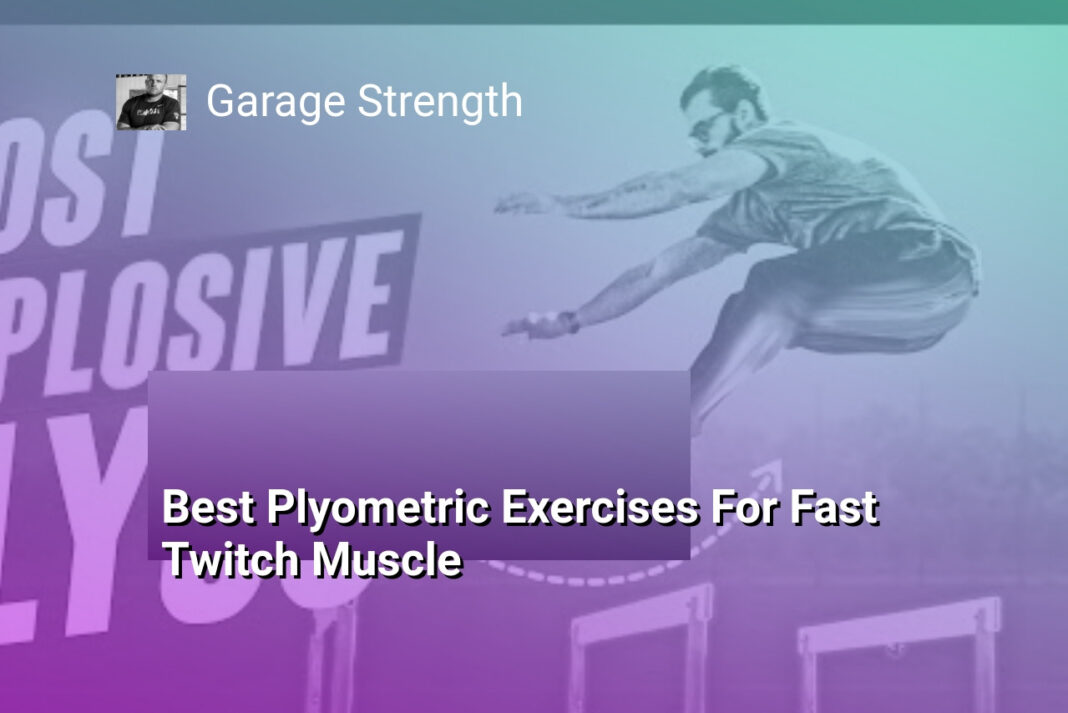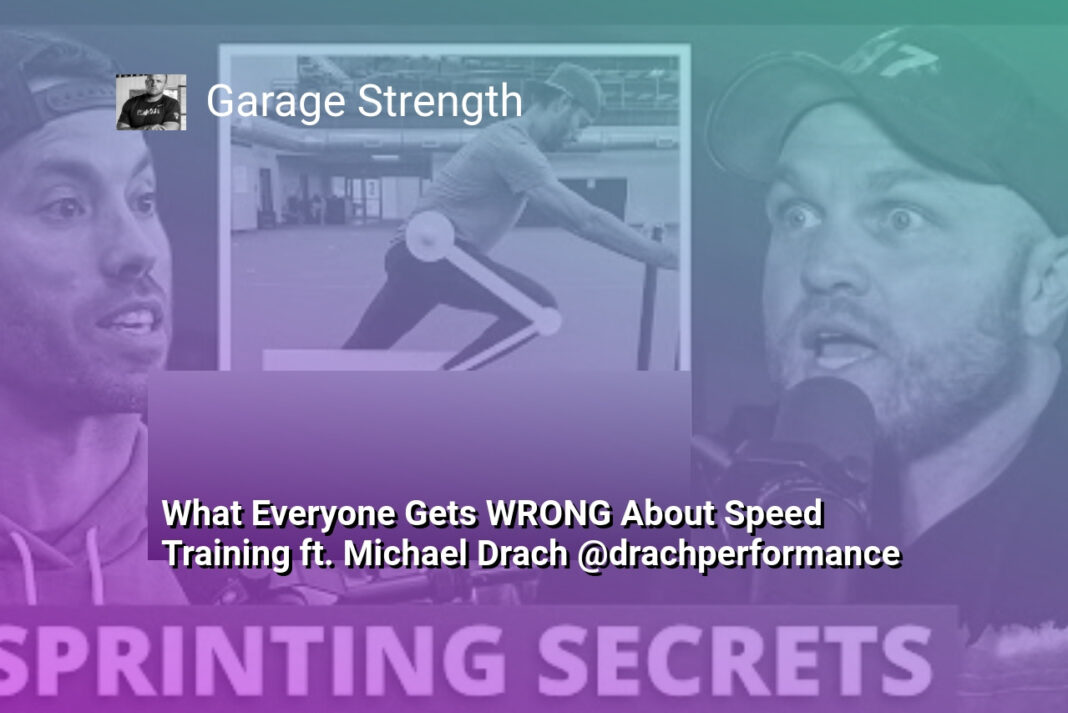The Bottom Line:
- The main theme of the text is to provide a series of plyometric exercises that can improve an individual’s fast-twitch muscle and overall athleticism. The exercises range from simple box jumps to more complex broad jumps and hurdle hops.
- The author shares their personal experiences and expertise, having participated in the Olympics and various world championships, as well as designing training programs for athletes and coaches.
- The text emphasizes the importance of proper technique and progression in these exercises, highlighting the need for athletes to develop the necessary strength, coordination, and explosiveness required for high-speed movements.
- The author introduces the concept of “twitchiness” and explains how different levels of twitchiness can be achieved through various exercises, such as the single-leg Pogo jump and the side-to-side jump.
- The text also discusses the integration of these plyometric exercises into a periodized strength training program, such as the one used in the author’s Peak Strength app, where the exercises are introduced and progressed based on the athlete’s phase of training.
Box Jumps for Explosive Power
Mastering the Box Jump for Explosive Power
The box jump is a versatile and effective plyometric exercise that can significantly enhance your explosive power and fast-twitch muscle development. This exercise is not only easy to execute but also offers various modifications to challenge athletes at different skill levels.
One of the key aspects of the box jump is the proper execution of the counter-movement and arm swing. Beginners or younger athletes may struggle with the coordination required, so it’s essential to start with a focus on the fundamentals. Begin with a controlled counter-movement, utilizing the arms to generate momentum, and gradually progress to a more explosive jump.
As you become more proficient, you can introduce variations to the box jump. Incorporating a pause between jumps can help develop the athlete’s ability to generate power and react quickly. Additionally, experimenting with different box heights and distances can challenge the athlete’s spatial awareness and ability to transfer horizontal momentum into vertical power.
Unlocking the Power of Single-Leg Pogo Jumps
Another valuable plyometric exercise for enhancing fast-twitch muscle development is the single-leg pogo jump. This exercise not only targets the lower body’s explosive power but also challenges the athlete’s balance, stability, and coordination.
Start by focusing on the execution of the single-leg pogo jump, emphasizing a quick ground contact time and high hip height. Encourage the athlete to drive the opposite leg up as they land, mimicking the whip-like motion observed in high-level sprinters.
As the athlete progresses, you can introduce additional challenges, such as incorporating a stutter step or performing the exercise without the use of hurdles. These variations will further develop the athlete’s ability to react quickly and generate power from a single-leg stance.
Integrating Lateral Plyometric Movements
To address the importance of hip and groin stability during high-speed movements, incorporating lateral plyometric exercises can be highly beneficial. One such exercise is the side-to-side jump, where the athlete jumps from one leg to the other, focusing on a quick ground contact time and a stable landing.
This exercise not only challenges the athlete’s lateral power but also requires a strong co-contraction of the hip musculature to maintain control and stability during the movement. As the athlete becomes more proficient, you can progress the exercise by increasing the distance or incorporating additional challenges, such as hurdles or cones.
By incorporating these plyometric exercises into your training program, you can effectively develop the fast-twitch muscle fibers essential for explosive athletic performance. Remember to monitor the athlete’s progress, adjust the difficulty as needed, and prioritize proper technique to ensure safe and effective training.
Single Leg Pogo Jumps for Reactive Strength
Mastering Single Leg Pogo Jumps for Explosive Power
The single leg pogo jump is a highly effective exercise for developing reactive strength and explosive power. This plyometric movement challenges your body to generate rapid, forceful contractions while minimizing ground contact time. By focusing on these key elements, you can optimize the stretch-shortening cycle and unlock greater athletic potential.
Proper Execution and Progression
Begin by practicing the single leg pogo jump without any additional equipment. Stand on one leg and perform a series of quick, bouncing movements, keeping your ground contact time as short as possible. Concentrate on driving your free leg up explosively, using the stretch-shortening cycle to generate maximum power.
As you become more comfortable with the movement, you can progress by adding mini-hurdles or cones to jump over. This introduces a horizontal component, requiring you to coordinate your leg drive with a controlled, broad jump. Start with a lower hurdle height and gradually increase the challenge as you master the technique.
Integrating Single Leg Pogo Jumps into Your Training
Single leg pogo jumps can be a valuable addition to your plyometric training regimen. Consider pairing them with bilateral exercises, such as broad jumps or box jumps, to create a comprehensive program that targets both unilateral and bilateral power development.
Incorporate these exercises into your warm-up routine or as a dedicated plyometric session, allowing for adequate rest and recovery between sets. Remember to maintain proper form throughout, focusing on explosive movements and minimizing ground contact time to maximize the benefits.
By mastering the single leg pogo jump, you’ll develop the reactive strength and fast-twitch muscle fiber activation necessary for enhanced athletic performance, whether you’re a sprinter, jumper, or any other type of athlete seeking to unlock their explosive potential.
Lateral Jumps for Hip Stability and Agility
Improving Lateral Agility and Hip Stability
Lateral jumps are a highly effective exercise for enhancing hip stability and overall agility. This dynamic movement challenges the body to generate power and control in the frontal plane, which is crucial for sports that require rapid changes of direction.
Lateral Jump Progressions
Start with a simple lateral jump, focusing on proper form and landing mechanics. Maintain an upright torso, engage the core, and land softly with knees slightly bent. As you become more comfortable, incorporate a pause between jumps to emphasize the eccentric and isometric control required.
For a greater challenge, progress to a lateral jump with a stutter step. The stutter step introduces an element of reactive agility, forcing the athlete to quickly shift their weight and change direction. Emphasize a quick, explosive push-off from the ground, using the arms to generate momentum.
Finally, advance to a lateral jump with a hurdle or obstacle. This variation requires the athlete to precisely gauge the distance, height, and timing of the jump, further enhancing their lateral agility and hip stability.
Integrating Lateral Jumps into Training
Lateral jumps can be effectively paired with other plyometric exercises to create a comprehensive training program. For example, you might start with a broad jump, immediately followed by a lateral jump, then transition into a vertical jump or box jump. This combination challenges the athlete to quickly shift between different planes of motion, mirroring the demands of many sports.
Remember to allow adequate rest periods between sets, as these high-intensity exercises can be taxing on the neuromuscular system. Gradually increase the difficulty and volume of the lateral jump progressions as the athlete’s skill and fitness level improves.
By incorporating lateral jumps into your training, you’ll develop the explosive power, agility, and hip stability necessary to excel in a wide range of athletic endeavors.
Broad to Box Jumps for Coordinated Movements
Mastering Broad to Box Jumps for Enhanced Coordination
The broad to box jump is a dynamic plyometric exercise that challenges your coordination and explosive power. This progression builds on the foundational box jump, adding an initial broad jump to engage your fast-twitch muscle fibers and improve your overall athleticism.
Start by standing a few feet away from a box or platform. Initiate the movement with a countermovement and swing of the arms, then explosively jump forward, landing on the box with control. Focus on maintaining good posture and generating power from your legs, not just your upper body.
As you become more comfortable with the broad to box jump, you can introduce variations to increase the difficulty and challenge your coordination further. One option is to incorporate a pause between the broad jump and box jump, forcing you to stabilize before the second explosive movement. Another variation is to perform a double-bounce on the box, landing and immediately rebounding up.
Developing Reactive Strength with Broad to Pogo Jumps
Building on the broad to box jump, the broad to pogo jump adds an element of reactive strength and rapid force production. Start in the same position, but instead of landing on a box, you’ll perform a series of quick, continuous pogo jumps on the same spot.
The key here is to minimize ground contact time and maximize the stretch-shortening cycle. Focus on driving your feet into the ground with maximum force, using your arms to generate additional power. As you become more proficient, try to increase your jump height and maintain a consistent rhythm.
This exercise not only develops reactive strength but also helps improve your coordination, balance, and ability to quickly change direction – all critical attributes for athletic performance.
Progressing to Broad to Hurdle Hops
The final progression in this sequence is the broad to hurdle hop. This exercise requires an even greater level of coordination and explosive power as you must navigate over hurdles or other low-level obstacles.
Begin with a broad jump, then immediately transition into a series of quick, explosive hops over the hurdles. Focus on maintaining good posture, generating power from your legs, and minimizing ground contact time. As you become more comfortable, you can increase the height of the hurdles or the distance between them to further challenge your abilities.
The broad to hurdle hop is an excellent drill for developing the reactive strength, agility, and coordination needed for sports like football, basketball, and track and field. By mastering this progression, you’ll be well on your way to unlocking your full athletic potential.
Broad to Hurdle Hops for Advanced Plyometrics
Mastering Broad to Hurdle Hops for Advanced Plyometrics
The broad to hurdle hop is a challenging plyometric exercise that takes your fast-twitch muscle development to the next level. This progression builds on the previous single-leg pogo jumps, challenging your body to transfer horizontal momentum into vertical power.
Start by setting up a low hurdle or box in front of you. Perform a broad jump, landing with control on the other side of the obstacle. Immediately upon landing, explode upwards, driving your knees high in a hurdle hop motion. Focus on minimizing ground contact time and maximizing the height of your hop.
As you master the basic broad to hurdle hop, you can progress the exercise by increasing the distance of the broad jump or the height of the hurdle. Another variation is to perform a broad jump to the first hurdle, then immediately hop over a second hurdle. This requires precise body control and timing to maintain your momentum through the sequence.
The key coaching cues for the broad to hurdle hop are:
Efficient Broad Jump Mechanics
Initiate the broad jump with a powerful arm swing and triple extension of the hips, knees, and ankles. Land softly with knees bent to absorb the impact.
Explosive Hurdle Hop
As soon as you land the broad jump, aggressively drive your knees up, minimizing ground contact time. Focus on achieving maximum height on the hurdle hop.
Smooth Rhythm and Continuity
Strive for a seamless transition from the broad jump into the hurdle hop. Avoid any pause or hesitation between the two movements.
Mastering the broad to hurdle hop will carryover to improved acceleration, change of direction, and reactive power in your sport. Incorporate this challenging plyometric exercise into your training program to elevate your athletic performance.





